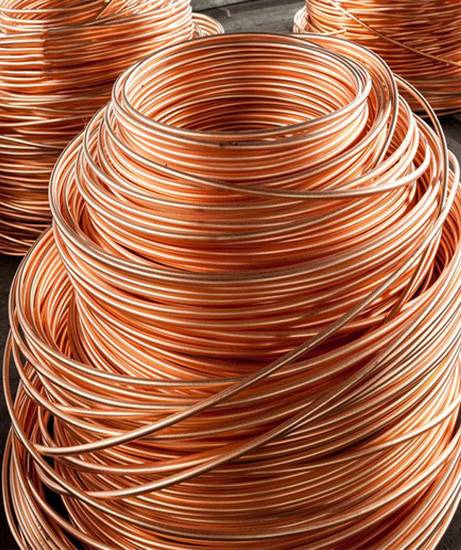
OXYGEN FREE HIGH CONDUTIVITY COPPER (OFHC)
Oxygen-free high-conductivity copper is produced by directly converting carefully selected refined cathodes under strictly controlled conditions to ensure the pure, oxygen-free metal remains uncontaminated throughout the processing.
The manufacturing process of OFHC (Oxygen-Free High Conductivity) copper ensures the production of a superior-grade metal with an outstanding copper purity of 99.996%. The negligible presence of impurities allows this copper type to exhibit the true properties of pure copper to an exceptional degree. Its key characteristics include excellent ductility, outstanding electrical and thermal conductivity, high impact resistance, impressive creep resistance, ease of welding, and low volatility even under high vacuum conditions. With less than 10 parts per million of oxygen, OFHC copper remains completely free from copper oxide particles.
Lower oxygen content in oxygen free high conductivity copper has many advantages over ETP copper as shown in the following table.

Tig welding in moist atmosphere

Hydrogen Embrittlement Test

Microstructure
ELECTROLYTIC TOUGH PITCH COPPER
| Chemical Composition | ||||
|---|---|---|---|---|
| Material | Normal Composition | Nearest Relevant Composition Specification | ||
| BS: 2870 | ISO | JIS | ||
| Electrolytic Tough Pitch H.C. Copper | ||||
| Cu – 99.90% Min. | C 101 | Cu ETP 1337 | H 3100 C 1100 | |
| Pb – 0.005% Max | ||||
| Bi – 0.001% Max | ||||
| O2 – 0.060% Max | ||||
TYPICAL MECHANICAL PROPERTIES
| Material | Temper | Tensile Strength N/mm2 | Elongation % on 50 mm G.L. | Vickers Hardness VPN | ISO | JIS |
|---|---|---|---|---|---|---|
| Electrolytic Tough Pitch H.C. Copper | ‘O | 210 Min | 35 Min | 55 Max | Cu ETP 1337 | H 3100 C 1100 |
| M | 210 Min | 35 Min | 65 Max | |||
| 1/2 H | 240 Min | 10 Min | 70 to 95 | |||
| H | 290 Min | – | 90 Min | |||
| ‘O’b : Annealed Condition | ||||||
| 1/2 Hv : Half Hard | ||||||
| Hb : Hard | ||||||
| * : Electric Conductivity at 20 Deg. Cel.100% IACS (For Cu ETP ‘O’ Temper) | ||||||
DEOXIDIZED PHOSPHOROUS COPPER
| Chemical Composition | ||||
|---|---|---|---|---|
| Material | Normal Composition | Nearest Relevant Composition Specification | ||
| BS: 2870 | ISO | JIS | ||
| Phosphorous Deoxidized Copper (DONA) | Cu – 99.85% Min P – 0.013-0.050% | C 106 | Cu DHP 1337 | H 3100 C 1220 |
| Material confirming to other National Specification e.g. ASTM, DIN etc. is also provided. | ||||
| Available in Strips, Sheets, Plates & Circles form. | ||||
| TYPICAL MECHANICAL PROPERTIES | ||||||
|---|---|---|---|---|---|---|
| Material | Temper | Tensile Strength N/mm2 | Elongation % on 50 mm G.L. | Vickers Hardness VPN | ISO | JIS |
| Phosphorous Deoxidized Copper | ‘O’ | 210 Min | 35 Min | 55 Max | Cu DHP 1337 | H 3100 C 1220 |
| M | 210 Min | 35 Min | 65 Max | |||
| 1/2 H | 240 Min | 10 Min | 70 to 95 | |||
| H | 290 Min | – | 90 Min | |||
| ‘O’b : Annealed Condition | ||||||
| 1/2 Hv : Half Hard | ||||||
| Hb : Hard | ||||||
PHOSPHORIZED LOW RESIDUAL PHOSPHORUS COPPER
| CHEMICAL COMPOSITION | ||||
|---|---|---|---|---|
| Material | Normal Composition | Nearest Relevant Composition Specification | ||
| IS | ASTM | EN | ||
| Phosphorized Low Residual Phosphorous Copper | Cu – 99.90% Min. P – 0.004 – 0.012 | IS :1545 : 1994 | B75 C12000 / Cu-DLP | N |
| TYPICAL MECHANICAL PROPERTIES | |||||||
|---|---|---|---|---|---|---|---|
| Material | Temper | Tensile Strength N/mm2 | Elongation % on 50 mm G.L. | Vickers Hardness VPN | Conductivity % IACS | ISO | ASTM |
| Phosphorized Low Residual Phosphorous Copper | ‘O’ | 205 Min | 40% Min | 60 Max | 90 % Min | IS : 1545 : 1994 | B 75 C 12000/Cu-DLP |
| Hb | 245 – 325 | – | 80 – 100 | 88 % Min | |||
| HD | 315 Min | – | 105 Min | ||||
| ‘O’ : Soft – Annealed Condition | |||||||
| Hb : Half Hard Condition | |||||||
| HD : Hard Condition | |||||||

CADMIUM COPPER
Pure, unalloyed copper is soft, ductile, and typically contains around 0.7% impurities. Cadmium copper alloys, classified as high copper alloys, consist of approximately 98–99% copper, 0.1–1.5% cadmium, and occasionally trace amounts of other materials. The addition of cadmium enhances the material’s resistance to softening at elevated temperatures. The greater the cadmium content, the higher the heat resistance of the alloy. Notably, small amounts of cadmium do not negatively impact the thermal and electrical conductivities or the mechanical properties of cadmium copper at room temperature.
Cadmium copper applications
- Trolley wire
- Heating pads
- Electric blanket elements
- Spring contacts
- Connectors
- High strength transmission lines
Cadmium copper is also commonly used in soldering applications, particularly for joining components in automobile and truck radiators, as well as in semiconductor packaging operations. The UNS alloy designations for cadmium copper alloys containing approximately 1% cadmium are C16200 and C16500, while alloys with 0.1 to 0.2% cadmium are designated as C14300. Notably, there are no cast cadmium copper alloys.
The microstructure of cadmium copper resembles that of pure copper materials. It is easily formed through cold working and hot forming processes. The microstructures of worked materials exhibit equiaxed, twinned grains, which may contain oxide inclusions distributed throughout the grains.
